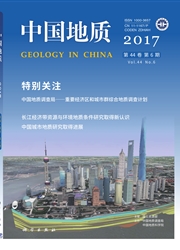

 中文摘要:
中文摘要:
西藏泽当蛇绿岩位于雅鲁藏布江缝合带东段,由地幔橄榄岩、辉长岩、玄武岩等组成,地幔橄榄岩中发育有少量辉石岩、辉长岩、异剥钙榴岩、斜长花岗岩和角闪辉长岩。本文研究的角闪辉长岩侵入于泽当地幔橄榄岩的辉石岩中,主要由角闪石、葡萄石+绿纤石和少量Fe-Ti氧化物组成。岩石中角闪石呈自形,伟晶结构,褐色,均一的干涉色,与交代成因的角闪石相比具有较高的Al2O3(7.0%~11.0%)、Ti O2(1.0%~2.5%)和Na2O(1.0%~1.9%)含量,指示其为岩浆成因;Fe-Ti氧化物以磁铁矿为主(Ti O2=1.2%~13.2%;Fe2O3=40.6%~61.4%;Fe O=31.1%~43.6%),与钛铁矿(Ti O2=36.2%~50.8%;Fe2O3=2.5%~24.6%;Fe O=33.0%~43.7%)经常呈矿物对共生或出溶钛铁矿,磁铁矿—钛铁矿计算矿物平衡氧逸度(-logfo2)为12.4~22.8,约为NNO+1,比正常MORB氧化程度高,指示岩浆结晶时具有较高的水逸度。其锆石εHf(t)值为11.0~19.8,显示亏损地幔源区特征。岩石地球化学分析显示其具有高的Al2O3(20.4%~22.4%)、Ti O2(1.0%~1.5%),低的Mg O(4.1%~5.5%)含量类似高铝玄武岩的特征。泽当角闪辉长岩可能由亏损地幔部分熔融形成的含水岩浆经过演化(分离结晶作用等)形成的低镁高铝类似高铝玄武岩的岩浆结晶形成。然而样品严重亏损轻稀土(LREE),与常见于岛弧区的高铝玄武岩不同,可能为蛇纹石化的洋壳或地幔橄榄岩在俯冲早期脱水使得地幔楔发生部分熔融导致。对泽当蛇绿岩中侵入岩及地幔橄榄岩进行更详细的调查研究将对揭示泽当蛇绿岩的形成环境构造背景提供更多的线索。
 英文摘要:
英文摘要:
Zetang ophiolite is mainly composed of peridotite, gabbro and basalt. Hornblende gabbro, which was intruded into the peridotite, comprises amphibole, prehnite + pumpellyite and minor Fe- Ti oxides. The amphibole in hornblende gabbro is brown euhedral with homogeneous interference color and has higher Al2O3(7.0%- 11.0%), Ti O2(1.0%- 2.5%), as well as Na2O(1.0%-1.9%) values than the amphibole of metasomatic genesis, implying that the amphibole is of primary magmatic origin. The Fe- Ti oxides consist of magnetite(Ti O2=1.2%- 13.2%; Fe2O3=40.6%- 61.4%; Fe O=31.1%- 43.6%) and ilmenite(Ti O2=36.2%- 50.8%;Fe2O3=2.5%- 24.6%; Fe O=33.0%- 43.7%). The ilmenites always exhibit trellis and sandwich textures or are closely spaced(composite type) in the magnetite host. The oxygen fugacities(expressed as- logfo2) of the Fe- Ti oxides calculated by ilmenitemagnetite geothermobarometry are 12.4-22.8(approximately NNO+1), indicating that the presence of high water activities during crystallization. The positive εHf(t) values(+ 11.0 to + 19.8) of the sample suggest that it came from depleted mantle(DM). The hornblende gabbro is characterized by high Al2O3(20.4%-22.4%) and Ti O2(1.0%-1.5%), low Mg O(4.1%-5.5%) values, similar to features of high- alumina basalt(HAB). The hornblende gabbro might have been formed by evolved mantle- derived hydrous magma rich in volatile, Ti and Al2O3. However, the sample shows depleted light rare earth element(LREE) patterns, which is different from features of HAB in the subduction zone. The rocks were probably formed by partial melting of mantle wedge induced by dehydration of serpentinized subducted oceanic lithosphere.
 同期刊论文项目
同期刊论文项目
 同项目期刊论文
同项目期刊论文
 期刊信息
期刊信息
